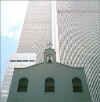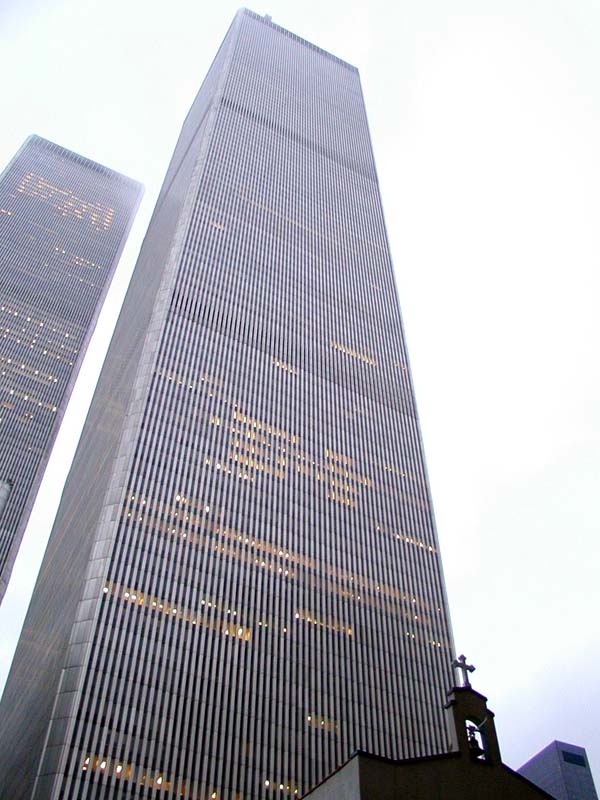|
|
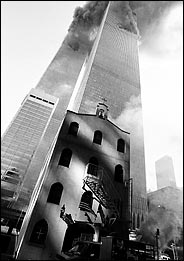
St. Nicholas Hellenic Orthodox Church was
destroyed together with the World Trade Center on 11 September 2001.
The church was located across the Liberty Street from the WTC towers,
between the Washington and West Streets.
The tiny church building was constructed around 1832. It originally was a
residence and later housed a tavern before the founders of the parish
purchased the structure. It measured 22 feet wide in front, 20 feet, 11
inches in the back, and about 56 feet long. It was 35 feet tall. On
three sides it was bounded by a parking lot.
Greek immigrants established St. Nicholas Church in 1916 and purchased the
structure for $25,000. It was one of two old calendar parishes under the
Archdiocese until 1993 when it switched to the Gregorian calendar. Among
the church's unique characteristics were its small size and its icons,
which were a gift from the last czar of Russia, Nicholas II.
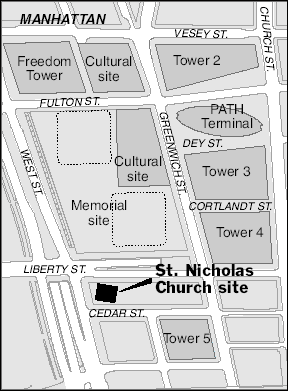
May 14, 2004
Solace on the Site of Disaster
By DAVID W. DUNLAP
St. Nicholas Greek Orthodox Church was crushed by the fall of the south
tower on Sept. 11.

Among the items that were salvaged from St. Nicholas Greek Orthodox Church
were, from top, a book and a bell from the altar, and a gong from the
bell that was atop the church. The most precious of the old church's
possessions were never recovered.
It is the smallest building planned at ground zero. But the architects who
will compete to design the new St. Nicholas Greek Orthodox Church may
face the biggest challenge.
They will be asked by Archbishop Demetrios, the primate of the Greek
Orthodox Church in America, for a design at once unmistakably
ecclesiastical yet in harmony with the bold secular architecture around
it, one that captures unearthly mystery in tangible dimensions and
conveys a sense of something outside human experience.
"Within this area, which experienced the horror of total catastrophe,
which was the ultimate in human ugliness, you have this type of place
which is not a house, not a business, not a museum, not a symphony
hall," the archbishop said.
"It's a religious place, which opens the realm of holiness: this total
other, the transcendent."
And all of this on a parcel of 5,200 square feet, set in a park across
Liberty Street from the main World Trade Center site, roughly the spot
where the little St. Nicholas Church stood until the morning of Sept.
11, 2001.
The new St. Nicholas will not be a simple parish church, Archbishop
Demetrios said, but a combination church and multiuse,
interdenominational center "that offers itself to people of all faiths
or even without faith." It would include an exhibition of the few
remnants of the old church, which was crushed by the fall of the south
tower.
These include icons of St. Dionysios of Zakynthos and the Zoodochos Pege,
or life-giving fountain; a small bell that once hung next to the altar;
a hand-embroidered velvet Bible covering; and wax candles fused into a
serpentine tangle.
St. Nicholas Church was founded in 1916 and soon moved into a modest
three-story structure at 155 Cedar Street, on a 22-by-55-foot lot, that
had been built as a private dwelling in the 1830's and later turned into
a tavern. The church added a fourth floor and a bell cote but still fell
106 stories shy of its giant neighbors to the north.
The congregation, about 70 people from Manhattan, Brooklyn, Queens,
Westchester County and New Jersey, now worships at SS. Constantine and
Helen Cathedral in Brooklyn. "It is the same faces, different building,"
said Peter Drakoulias, a board member of the church. "Same people. Same
hearts. Same hopes."
Mr. Drakoulias said church members supported the idea of rebuilding St.
Nicholas as a place of solace and remembrance in which anyone would feel
comfortable. "It's an essential part of the mission, as far as the
congregation is concerned," he said.
More than $2 million in contributions have been made to the rebuilding
effort. In January, the mayor of Bari, Italy, site of the 11th-century
San Nicola Basilica, donated 258,000 euros (about $307,000).
The lot on which St. Nicholas stood will most likely be condemned by the
state; that is, taken under eminent domain. In return, the church will
receive a larger parcel - 65 by 80 feet - on the same block but closer
to Liberty Street.
The details are not yet set, said Kevin M. Rampe, president of the Lower
Manhattan Development Corporation.
"The historic nature of the church and the fact that it's been there so
long has convinced everyone that trying to provide space for it would be
important to the future, in terms of telling the story of what happened
Sept. 11," Mr. Rampe said.
Daniel Libeskind, the master planner of the trade center project, said the
church was "part of the spiritual legacy of the site."
"St. Nicholas, as small as it was, was an incredibly moving piece of Lower
Manhattan," he said. "It glowed with diversity and the beauty of
meditation."
Archbishop Demetrios envisions an international design contest, once the
specifics of the site are fixed. Widely published renderings of the
trade center memorial showed St. Nicholas with a gable roof and belfry,
but this was a kind of visual space holder.
The question is whether the new St. Nicholas needs traditional features to
assert its ecclesiastical identity. "You don't expect a pure
Byzantine-style church," the archbishop said. "On the other hand, if you
depart too radically as a totally modern structure, then that is not
perhaps the best way."
Negotiating this line will be difficult, allowed Nicholas P. Koutsomitis,
an architect on the board of the Archdiocesan Cathedral of the Holy
Trinity in Manhattan who is developing the master plan for the new St.
Nicholas.
"Traditionally, a Byzantine dome has been strongly identified with the
Greek Orthodox church," Mr. Koutsomitis said. "The trick, in my opinion,
will be to produce something that somehow has a visible element of that,
yet is more of a modern architectural piece of sculpture."
One of the younger Greek Orthodox churches in Manhattan, St. Spyridon in
Washington Heights, was built in the early 50's, when the
glass-and-steel International style was on the rise.
Yet its interior is extravagantly, exuberantly traditional; every square
inch is ornamented with Byzantine artwork under a high dome depicting
Christ.
"The traditionalist in me says that the interior should follow a Byzantine
motif," said Steve Hantzarides, president of the board of St. Spyridon.
But Constantine L. Tsomides, a Massachusetts architect who has followed
the redevelopment of St. Nicholas, cautioned the archdiocese in 2002
that too literal a Byzantine plan "will result in a building resembling
an artificial theme park."
The mixture of the historic and the contemporary at ground zero runs
deeper than most New Yorkers know. The most precious of the old church's
possessions - relics, or tiny bone fragments, of St. Nicholas, St.
Catherine and St. Sava - were never recovered.
To Archbishop Demetrios, the notion that the saints' relics were
intermingled in the dust with the remains of the attack victims only
serves to sanctify the site further. "Imagine," he said, "a cemetery
that somehow has been a burial place for many centuries."
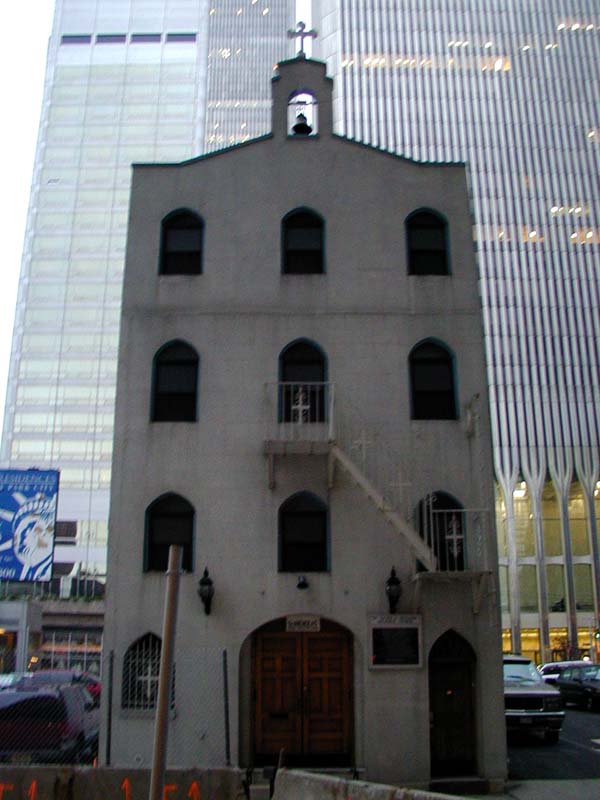
|
|
notes
|
"Upon this Rock I will Rebuild my Church"
The Rebuilding of St. Nicholas Greek Orthodox Church
On September 11, 2001 the barbaric attack
not only destroyed the majestic Twin Towers but also the tiny yet
historic St. Nicholas Greek Orthodox Church, located south of the second
tower of the World Trade Center. In the aftermath of its destruction,
very little survived: two icons, one of St. Dionysios of Zakynthos and
the other of the Zoodochos Pege, along with a few liturgical items, a
book, and some candles.
Within days, the Archbishop traveled personally to Ground Zero, setting
foot on the site where the Church of St. Nicholas stood, in order to
conduct a memorial service for the victims of those who perished in the
attacks and to offer prayers for the families in mourning.
On the Feast Day of St. Nicholas, December 6, the Archbishop, joined by
His Eminence Archbishop Iakovos and area clergy, celebrated a somber
Vespers and memorial service near where the Church once stood. Six
months after the attacks, His All Holiness Ecumenical Patriarch
Bartholomew also journeyed to this sacred site and presided at a
memorial service with family members of the victims.
Though small in stature, St. Nicholas Greek Orthodox Church was a place
of ministry and worship both for her parishioners and also for local
residents and workers in the Financial District of Manhattan who would
pass by and often enter the Church. Following its collapse, the legacy
of this tiny Church continues to dramatically impact peoples’ lives, and
donations of almost $2 million have been received, as well as additional
pledges of construction materials and appointments for the complete
rebuilding of the Church. The city of Bari, Italy, where the relics of
St. Nicholas were originally bestowed, has donated $250,000. The
government of Greece has contributed $750,000 to these efforts, and the
Ecumenical Patriarchate has given $50,000. The Governor of the State of
New York, George Pataki, met with the Archbishop and pledged his support
for including a new St. Nicholas in the redevelopment of the World Trade
Center site.
The task of rebuilding the Church of St. Nicholas involves careful
coordination, planning and vision. To this end, His Eminence Archbishop
Demetrios has appointed a committee to oversee the rebuilding project.
In accomplishing their objectives, the committee has met with the Lower
Manhattan Development Corporation so that the task of rebuilding St.
Nicholas may be properly incorporated into the concept plans for the
reconstruction of the World Trade Center site located at Ground Zero.
These concept plans, which are the product of an inclusive process,
envision the rebuilding of the historic Church of St. Nicholas as a
functioning parish, ministering once again to the needs of her faithful.
His Eminence, however, also sees the rebuilding of St. Nicholas as a
matter of spiritual destiny, so that the millions of people who will
visit the historic site of Ground Zero may find marking the place of a
national tragedy, a sanctuary of solace and prayer, a concrete and
visible testimony of renewed faith and hope.
|
